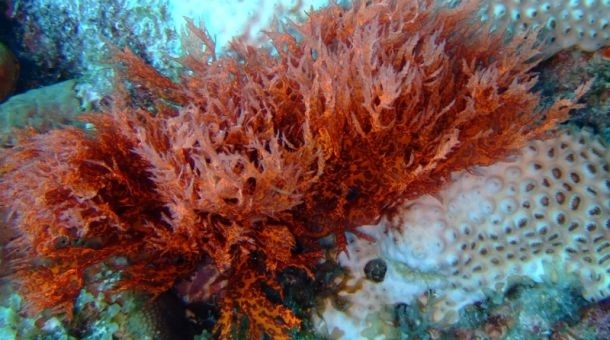


Barry O’Keefe presented the results of clinical trials of a protein isolated from red algae of the genus Griffithsia. The substance acts against HIV and several coronaviruses (photo: John Martin Davies/Wikimedia Commons)
Published on 08/29/2022
By André Julião in Itatiba (Brazil) | Agência FAPESP – The search for natural compounds has gained momentum in recent decades thanks to the use of techniques such as fractionation, which detects small amounts of substances present in plants, animals and microorganisms. The successes include anti-viral agents, which are particularly relevant during a pandemic.
“Natural Product Discovery in the 21st Century” was the title of a presentation by Barry O’Keefe, Director of the Molecular Targets Program at the Center for Cancer Research in the United States National Cancer Institute (NCI). He spoke to a live audience of 60 young researchers on August 9, 2022, the second day of the FAPESP 60 Years School on Exact, Natural and Life Sciences held in Itatiba, São Paulo state, Brazil.
“The search for natural products traditionally used mixtures that could contain hundreds or even thousands of compounds that were viscous, colored, fluorescent and hence very hard to study. More recently, by partially purifying these extracts, it’s been possible to build libraries of compounds that can be analyzed by modern molecule discovery techniques, reducing the number of assays and increasing the probability of finding molecules that are important to human health,” O’Keefe told Agência FAPESP.
These libraries can be provided by NCI to researchers who want to combat several diseases by looking for natural compounds active against different infectious agents and other molecular targets.
“It’s very hard for a young researcher to get funding for fieldwork to collect organisms and produce extracts and fractions,” he said. “These databases enable them to conduct research on natural products without having to do all that.”
O’Keefe presented recent results from his center, such as clinical trials of an anti-viral protein isolated from red algae of the genus Griffithsia, a native of New Zealand. The compound had already been shown to be active against HIV, the virus that causes AIDS, and to have a number of advantages, such as stability at high temperatures. In 2010, the researchers obtained good results in vitro and in animals against the SARS-CoV and MERS-CoV coronaviruses. More recent studies show that the substance also acts against SARS-CoV-2, the virus that causes COVID-19.
“The action mechanism is unique, differing from what we see in the vaccines, monoclonal antibodies and inhibitors currently used against SARS-CoV-2,” he said. “I believe we have something that can be used in a preventive situation. Even if it doesn’t come to market now, there’s a worldwide interest in the potential emergence of more pandemic viruses. It’s important to have broad-spectrum anti-virals that can be used against new viruses of concern,” he said.
Using the same protein, his group also developed a gel designed to prevent HIV from penetrating the vagina. If successful, the strategy will be one of only a few that protect women regardless of what their male partners may want.
“Men can use condoms and may be circumcised. Women don’t have many options. We need international support to empower women so that they can have agents like this for protection against HIV without depending on men,” he said.
Physics of cells
On the same day, Brazilian-American physicist José Nelson Onuchic, a professor at Rice University (USA), spoke about his research to understand how the structure of the cell nucleus controls gene expression.
“Proteins have a very well-defined structure. The nucleus doesn’t. It has a certain structural behavior, but it’s much more than a group of structures. It can’t be explained in terms of a structure but of how this group is formed,” he said.
The findings of this type of study can be useful for countless research lines, which explains why Onuchic has so many partnerships in various parts of the world. “It’s not just about having good data or good models, but something in between. We're trying to combine these two things by using what’s best in the exact sciences and in the biological sciences,” he said.
Social impact of artificial intelligence
Virgilio Almeida, a professor of computer science at the Federal University of Minas Gerais (UFMG) in Brazil, spoke about the research challenges relating to the social impact of artificial intelligence, presenting studies showing how algorithms can have a racist and sexist bias, and how they can lead people with moderate views to support hate speech.
Understanding these phenomena is essential both to create rules for platforms to apply to users and to formulate more comprehensive regulation of the kind currently being discussed by the European Union.
Source: https://agencia.fapesp.br/39477